Apple Mac mini Review (Mid 2010)
by Anand Lal Shimpi on August 9, 2010 3:37 AM ESTA Fully Functional Mac HTPC
I can’t help but think of the new Mac mini as Apple’s answer to the ION box. The big selling point for ION boxes like Zotac’s HD-ID11 is to use them with Xbox Media Center. Think of XBMC as an open-source, play anything alternative to Windows Media Center. Point it at music, pictures and movies on your hard drive or a network share and you’ve got a skinnable 10ft-UI that you can use to browse them.
The Linux build of XBMC was particularly great for ION machines because it took advantage of NVIDIA’s video decode engine via the Linux VDAPU API. Unfortunately, the OS X version didn’t have the same feature...until recently that is.
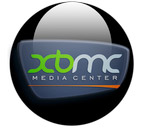
A couple of months ago Apple exposed the hooks necessary for software developers to take advantage of GPU accelerated video decode. Using the VDADecoder API, 3rd party developers are able to send compressed video frames to a supported GPU rather than the CPU for decoding. GPUs supported by the accelerated video decode API are the GeForce 9400M, GeForce 320M, and GeForce GT 330M. The one in the middle is in the Mac mini. And now you see where I’m headed with this.
The current official build of XBMC for OS X is still Camelot, v9.11. Camelot lacks support for VDADecoder and isn’t going to do what we want. The nightly builds however do support the API. I downloaded r31718 and ran it on the mini:
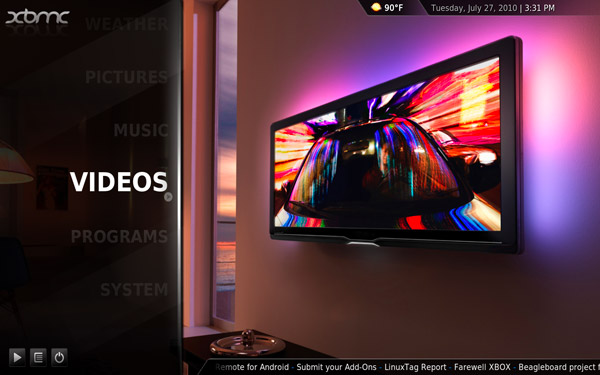
What you see above is the default UI, however it’s fully skinnable and there are tons of custom UIs to choose from if you want something different. Video playback worked right away on the Mac mini and was perfectly smooth. Below you’ll see CPU utilization while playing a 1080p mkv over the network:
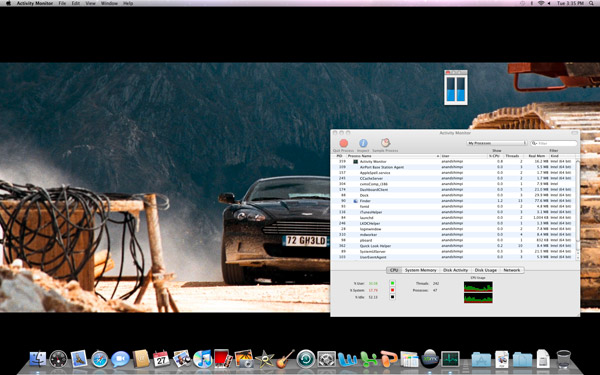
The 40% CPU utilization seemed a bit high but I didn't have any dropped frames. Other users have complained about running at half frame rate with XBMC playing back full Blu-ray rips.
As an HTPC, the Mac mini is very much an Apple ION box, just faster and more power efficient, not to mention more expensive. The styling is really hit or miss as an HTPC. Most HTPC equipment is rack sized and, well, black. But if you can pull it off, the redesigned Mac mini does look pretty slick.
The OS does surprisingly well as an HTPC. You get a slider to adjust the amount of overscan/underscan, and the NVIDIA drivers appear to detect and enable 24Hz support.
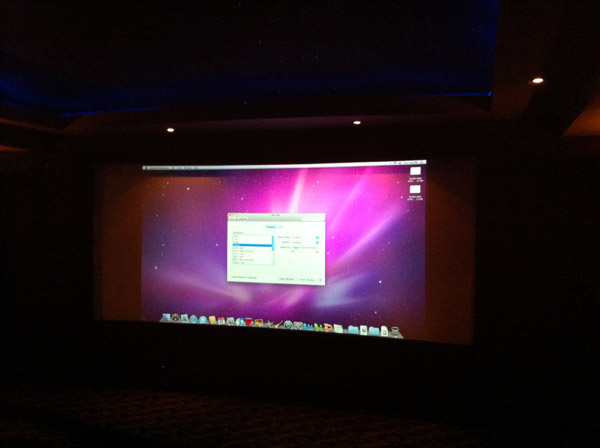
2010 Mac mini hooked up to a JVC RS2 projector
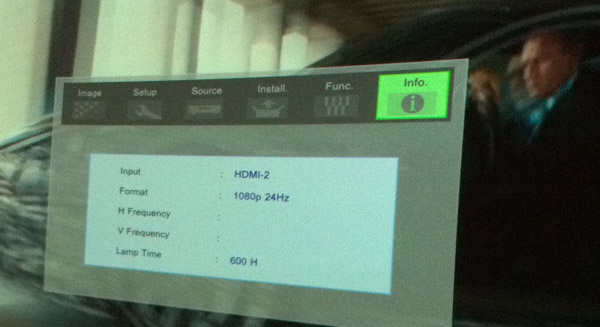
Front Row ships with OS X and acts as a decent 10-ft UI, but with XBMC, VLC or any similar 3rd party player you can bitstream 6-channel Dolby Digital or DTS audio over HDMI. Bitstreaming works flawlessly. My Integra DTC-9.8 pre-processor detected both DD and DTS signals without any fiddling.

The only thing you’re missing is TrueHD/DTS-HD MA bitstreaming and of course Blu-ray support. The former is a limitation all ION systems have as well, you need to go to a dedicated BD player or Clarkdale based HTPC to get TrueHD/DTS-HD MA support. The absence of a Blu-ray drive is an issue, making the Mac mini useful for DVD playback or playing local/network HD content. For ION boxes this isn’t a problem, but since we’re talking about a $699 machine with no way of enabling internal Blu-ray playback it is a definite downside.

The other major complaint about the Mac mini has to do with input devices. The mini doesn’t ship with a remote by default, which is just absurd for a $699 computer that is just begging to be used as an HTPC. Older Apple remotes work just fine, and presumably the new model will too, but Apple should’ve thrown one in. I get that you don’t make $3.25B in one quarter by giving everyone free remotes but keeping users happy should still be job-1.










93 Comments
View All Comments
CharonPDX - Monday, August 9, 2010 - link
People talk about how Apple is incapable of switching to the i3/i5/i7 plus a discrete GPU because of size constraints...Yet they forget that the original MacBook Air and the original Mac MIni were both three-chip solutions, with CPU, Intel Northbridge, and Intel Southbridge. If they could fit all three at some time in the past, why can't they fit three now? (CPU, Intel chipset, and nVidia/ATI GPU.)
Especially the mini, whose motherboard has GAINED area. (Not much, since it doesn't fill the whole newly-enlarged chassis, but it did gain a little.)
james.jwb - Monday, August 9, 2010 - link
Aggressive profit requirements per sale at Apple is probably a major reason.Penti - Monday, August 9, 2010 - link
Of course they can, redesigning the boards. But for a discrete mobile gpu too, they also need room for the added memories just like in the MBPs. (Well there's two sides of a PCB). It's a design choice not a limit. They could probably put something like Mobility HD5650 without upping the price and up the ram to 4GB and still make a lot of money. i5-520M 2.4GHz and HM55 costs $265 from Intel, though they also have a much higher power usage. P8600 goes for $209 plus nVidias 320M chipset. The same money + gpu. But it's worse in europe any way since they priced it when the dollar was high, so the mac mini is 809 euros (incl 19% sales tax) that's 900 US dollars before taxes. So we pay over a thousand dollars for something that goes for 699 in the states. For that kind of money 4-8GB, Mobility HD5650, faster drive etc should be standard. It should rather be something like €630. So we pay almost a 30% overprice. On a product that has a 20-30% margin easily.GeorgeH - Monday, August 9, 2010 - link
The current MacBook Air has a bigger battery than the original, so 3 chips (and the extra cooling hardware that would be required for a discrete GPU) wouldn't fit without sacrificing battery life.Penti - Monday, August 9, 2010 - link
Yes it's pretty busy already, http://guide-images.ifixit.net/igi/AaB5PK5d35HGTsZ... & http://guide-images.ifixit.net/igi/KJJyYGCKwbfhmAJ... in the Air. Much more room in the Mac Mini. Enough for discrete graphics I would say, with a serious redesign. Higher density DRAM (x16) might help (some) in the MB Air though.Penti - Monday, August 9, 2010 - link
And the redesigned board (later mid 2009), http://cart-products.ifixit.net/cart-products/ULXA... & http://cart-products.ifixit.net/cart-products/Ti4N... No more room there.Penti - Monday, August 9, 2010 - link
Just to add, mobile discrete GPU will be too much for a 40Wh battery as the macbook Air is using any way.solipsism - Tuesday, August 10, 2010 - link
YOu seem to be forgetting the rounder edges on the case reducing the footprint over a square 7.7”x7.7” footprint, the placement of the components and the PSU which now resides inside the Mini for the first time.Unless it’s using TARDIS technology that MoBo isn’t likely to be big enough.You also have to account for the engineering of larger heat sinks, more or bigger fans and potentially increased power needs. It’s not the simple achievement you are making it out to be.
My guess is that these small machines will get the Core-i when they remove the ODD. They aren’t going to add a $500 9.5mm slot-loading Blu-ray drive and they haven’t added AACS to Mac OS X so you all can stop scratching your head over what should be obvious. They are going to drop ODDs from notebooks and small PCs and move forward from there.
farhadd - Monday, August 9, 2010 - link
You can use any keyboard you like, not just an Apple. F12 functions as the eject key on non-apple keyboards. And you can customize the keys to make the command / option keys whatever you like, not just the windows / alt key that it defaults to.farhadd - Monday, August 9, 2010 - link
Apple still sells white macbooks with 2GB of RAM standard.